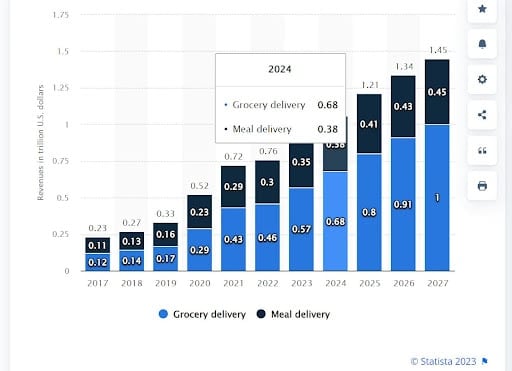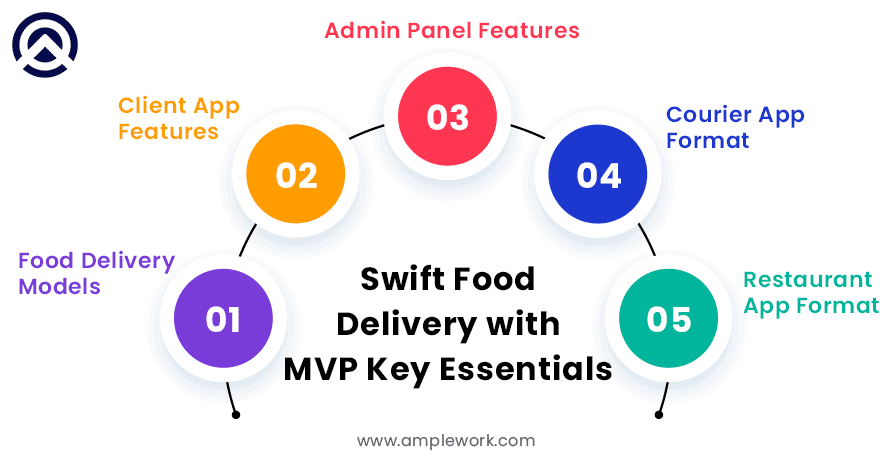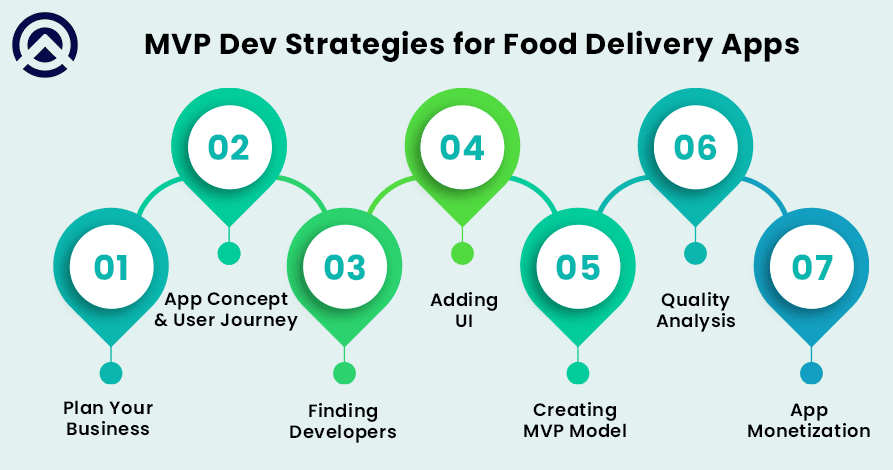Tracking Your Food Delivery Startup: A Comprehensive MVP Development Guide
In current times, people tend to explore new ways whether it is about choosing trendy fashion styles or making fancy food choices. In this context, the landscape of the food industry is continuously expanding and making bigger contributions to the global economy. Don’t you think, with the invention of a food delivery startup, your favorite food choice is getting delivered to your doorstep? Irrespective of the choice, Italian or Thai food whatever you want to order. Yes, food delivery apps or food delivery startups are the most contributing factors to the growing food industry. In this revolutionary environment, many organizations are shifting their interest towards food startups. In addition to this, the research by Statista highlights the same fact.

According to the above figure, the revenue generation of the online food delivery market recorded a value of approximately 1 trillion US dollars. Which is expected to increase by 1.4 trillion US dollars by 2027. This indicates that the food delivery process is continuously upgrading with different valuable assets like technology and infrastructure. The process of food delivery MVP development requires you to take accurate steps. This requires proper guidance and an adequate development technique.
While considering any startup, these software platforms can be developed with the help of the Minimum Viable Product Development (MVP) technique. The MVP software development is not just a development strategy, it is a complete guiding philosophy. That can reform your food startup application and services with mandatory features along with minimum cost. This technique provides advantages like proper testing of the startup ideas, the chance to gather valuable consumer feedback, and opening up with a full-scale product launch.
Blog Highlights
This blog can be a perfect source to guide you to start a food delivery startup or speed up the existing one with the emergence of effective MVP development services for startups. The major highlights of this are presenting the key components of developing an MVP-based platform and key development strategies. Let’s read about the successful recipe of the food delivery business app development through the MVP software development technique.
Key Factors of MVP Development to Fast-Track Food Delivery

1. Types of Food Delivery App Models
The food delivery industry operates on three primary business models. Each offers unique advantages for an MVP development company or an individual. The Order Only Model serves as a platform connecting customers and restaurants, allowing users to place orders seamlessly without the need for restaurants to invest in extensive promotions. In the Order and delivery Model, food startups lacking dedicated delivery systems find substantial support. Relieving them of the need to manage personnel, vehicles, or delivery logistics. The integration of MVP development services for startups works on renovating the existing curriculum of food delivery businesses.
The Fully Integrated Model, a newer entrant in the food delivery landscape, involves the app owner overseeing the entire process. From food preparation to delivery. While establishments following this model may have more limited menus. They provide customers the convenience of having their meals delivered to their doorstep, either hot or frozen, ready for heating and serving. Whether it is expanding restaurant reach or streamlining delivery logistics. These diverse models cater to the varying needs of the evolving food delivery startups in USA.
2. Features of Client-Side Application
The client application is the project’s focal point, requiring a user-friendly UI/UX design for maximum user attraction. Key MVP app development functions include versatile registration options, geolocation-based restaurant search with filters, real-time courier tracking, diverse payment method integration, and pop-up notifications for order status updates. Users can conveniently register via social networks like Facebook or Google, and developers can utilize their respective SDKs. further for location tracking, Google Location API and Location Framework are recommended. That requires you to hire an Android developer or hire iOS app developer. Secure order payments can be facilitated through multiple payment methods. Pop-up notifications using services like Amazon SNS and Firebase Cloud Messaging keep users informed about order progress. Lastly, ratings and reviews for user feedback can be implemented through platforms like Microsoft Azure and AWS.
3. Admin Panel Features
The admin panel, attributed to the application or platform owner, serves as the linchpin for effective business management. This central hub enables the admin to monitor and regulate various aspects of the application, facilitating the implementation of new functionalities and improvements to the user experience. In addition to accessing other panels, the admin panel incorporates crucial features. The dashboard within this panel empowers administrators to meticulously control all aspects of the MVP application development process, from user lists and active users to managing cinemas, movies, bookings, earnings, shows, and venues.
The Add/Block Feature, akin to user profile management, extends the admin’s authority to handle promotional elements such as promo codes and coupons. Another pivotal aspect is the Usage Analytics feature, which provides real-time insights into user search journeys. Admins can harness this capability to collect, analyze, and visualize data, offering valuable insights for refining user experience, identifying content gaps, and optimizing search results for heightened capabilities. The admin panel stands as the command center, orchestrating the seamless operation and evolution of the entire food delivery MVP development process.
Also read: Static Application Security Testing: SAST Basics
4. Courier Application Format
The courier application, designed for simplicity and functionality, prioritizes ease of use for couriers who are constantly on the move. Emphasizing mobility, it is recommended to provide a mobile-only version. The MVP app development company should include essential functions such as registration and login, offering couriers options like social media, email, phone number, and password for user authentication. To enhance navigation, the MVP app development should integrate convenient maps with optimal routes, utilizing the Google Maps Platform for Android and Location Framework for iOS. To ensure efficiency, couriers should have access to comprehensive order information, including restaurant address, delivery address, and delivery time. This streamlined courier application aims to facilitate smooth operations and convenience for delivery personnel while on the go.
5. Restaurant Application Format
In the realm of food delivery app development, the restaurant panel is equipped with features designed specifically for food delivery startups or restaurant owners. To gain access to the app, owners undergo a login and registration process, supplemented by the submission of additional documentation to authenticate their business. Upon logging in, restaurant owners are directed to their dashboard, offering a comprehensive view of received, pending, and completed orders. This dashboard also provides detailed information about each order, facilitating efficient order management. A pivotal feature within the restaurant panel is the “Order Details” section, allowing owners to decline orders they cannot fulfill based on specific constraints, such as the absence of a home delivery service or the unavailability of certain food items.
The “Account Management” feature grants each restaurant the flexibility to tailor its app profile. Owners can upload visuals like restaurant pictures, logos, and food images, set minimum order quantities, specify delivery charges, and manage operating hours. Involvement in these features can easily enterprise mobile app development company. This section also serves as a platform to showcase ongoing offers and discounts. Within the “Payment” section, restaurant owners can offer users diverse payment options, including direct transfers to the owner’s account, PayPal, or integration with digital wallets. These tailored features within the restaurant panel aim to streamline order management, enhance visibility, and offer a seamless experience for restaurant owners participating in the food delivery app ecosystem.
Also Read: How much does it cost to develop a food delivery app?
The Development Strategies of an MVP-based Food Delivery Platform

1. Developing a Business Plan
The journey of creating a successful MVP-based food delivery platform begins with a well-thought-out business plan. Define the target audience, market niche, and unique selling propositions. Conduct thorough market research to identify competitors, challenges, and opportunities. This practice guides to outline the revenue model and sets a clear business goal. A robust business plan serves as a roadmap, guiding the MVP software development process and helping secure support from stakeholders.
2. Creation of Application Concept and User Journey
Having gained a profound comprehension of the market, the subsequent step involves formulating a concept for your food delivery startups. This includes delineating the app’s fundamental features and functionalities and outlining the user journey. Additionally, it is crucial to contemplate the app’s branding and visual identity, ensuring it resonates with the preferences of your target audience. The user journey must be instinctive and straightforward to navigate, enabling customers to swiftly and effortlessly place orders. To gain insights into the user journey for a mobile application, engaging in discussions with a food delivery MVP development company can be beneficial. They can assist you in recognizing and addressing challenges related to the user interface (UI) and user experience (UX) design, ensuring that the app is not only visually appealing but also user-friendly. Consistency in design across all screens is imperative and should align seamlessly with the app’s branding and visual identity
3. Finding Proper Developers
Building a top-notch food delivery MVP development platform requires a skilled development team. Look for developers experienced in creating similar applications, preferably those with expertise in mobile app development, backend systems, and database management. Consider factors such as technical proficiency, industry knowledge, and a track record of successful projects when selecting your development team.
4. Designing the User Interfaces
User experience is paramount in the food delivery industry. Engage a talented team of UI/UX designers to create intuitive and visually appealing interfaces. Prioritize simplicity in navigation, ensuring a seamless and enjoyable experience for both customers and delivery partners. Pay attention to design elements that enhance brand identity and differentiate your platform from competitors.
5. Creating the MVP Model
The Minimum Viable Product (MVP) is the initial version of your food delivery platform that includes essential features for functionality. Focus on core elements such as order placement, real-time tracking, payment processing, and user registration. MVP application development requires scalability in mind, allowing for future feature enhancements based on user feedback and market demands. The goal is to launch quickly, gather user data, and iterate based on actual usage patterns.
6. Quality Analysis of the Product
A thorough quality analysis is crucial to ensure a bug-free and reliable food delivery MVP development platform. Conduct rigorous testing of each feature to identify and rectify potential issues. Perform usability testing to assess the user experience and gather feedback for improvements. Implementing a comprehensive quality assurance process contributes to the overall stability and performance of the food delivery platform.
Also read: Revolutionizing Mobile Payments Solutions with Full-Stack Development
7. Application Monetization
Determine the most effective monetization strategy for your food delivery MVP development platform. Options include delivery fees, subscription models, partnerships, and advertising. Evaluate the preferences of your target audience and industry trends to choose a sustainable revenue model. Striking the right balance between profitability and user satisfaction is key to long-term success.
Read more: Best Food Delivery Apps for Android & iOS
Conclusion
In the realm of rapidly advancing food delivery startups, the significance of MVP application development advancement cannot be overstated. It plays a pivotal role in expediting the development process. Ensure swift progress and success for the food delivery MVP development venture. Serving as the cornerstone for making data-driven decisions, MVP Advancement leverages user feedback and responds promptly to market demands, providing tailored insights specific to the food delivery industry. In the fast-paced landscape of the digital food service sector, an emphasis on evidence-driven development and optimization is crucial. Visionary developers and forward-thinking organizations in the food delivery space are diligently employing MVP application development strategies to enhance their platforms through empirical analysis.
Enterprises like Amplework, a distinguished player in the MVP app development industry with over 5+ years of expertise, showcase excellence in fast-tracking food delivery startups. Our committed team consistently exceeds client expectations, establishing a reputation for reliability. We have achieved noteworthy milestones, contributing to the success of various food delivery mobile app development company. Visit our website to explore our MVP development services tailored for the food delivery sector. Collaborate with Amplework to accelerate your food delivery startup’s journey through data-driven decision-making, ensuring success, and enhancing the quality of your platform to satisfy both your business needs and customer expectations.


 sales@amplework.com
sales@amplework.com
 (+91) 9636-962-228
(+91) 9636-962-228





